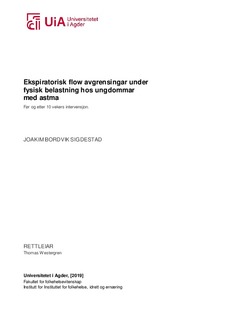| dc.contributor.author | Sigdestad, Joakim Bordvik | |
| dc.date.accessioned | 2019-11-13T12:44:43Z | |
| dc.date.available | 2019-11-13T12:44:43Z | |
| dc.date.issued | 2019 | |
| dc.identifier.uri | http://hdl.handle.net/11250/2628253 | |
| dc.description | Masteroppgave folkehelsevitenskap ME516 - Universitetet i Agder 2019 | nb_NO |
| dc.description.abstract | Background:Asthma is a chronic inflammatory disorder associated with variable airflo w obstruction and bronchial hyperresponsivness. Asthma may interfere with the ability of childre n and adolescents to participatein physical activity, as well ascreatebarriers towards involvement. Physical activity is an important stimulus for asthma symptoms. Exercise-induced bronchoconstriction is traditionally used when physical activity is the cause of asthma symptoms, but this is measured after exercise. There is little knowledge about flow limitat io n during exercise. Aim:The purpose of this study is to investigate expiratory flow limitation during physical load examination relatedto oxygen intakein adolescents with asthma. Design and methods:Atotalof15 (9 boys) adolescents with asthma completed the intervention, which consisted of 2x60 minutes per week for 10 weeks. After baseline spirometry, participants performed a cardiopulmonary exercisetest before and after the intervention. The tidal exercise flow-volume loops were recorded every other minuteto the limit of their toleranceand placed within the maximal forced vital capacity.Findings: 14 (8 boys) of the participantsexperienced expiratory flow limitation during cardiopulmonary exercise testing atpre and/or post-test. None of the participants experienced expiratory flow limitation at 45%VO2peak, but at 65%VO2peakexpiratory flow limitat io n occurred in 5/3 (pre/post).Conclusion: Most adolescents had expiratory flow limitation during the exercise test. No regression was found in the change of time for expiratory flow limitationfirst exhibited or for change of time for max versus time VO2peakor %VO2peakwhenitfirst exhibited. There was also no regression between the change ofthe maximum percent expiratory flow limitationversus time VO2peak or %VO2peakat max.
Keywords: pulmonary, spirometry, EFL, cardiopulmonary exercise testing, physical activity | nb_NO |
| dc.language.iso | nno | nb_NO |
| dc.publisher | Universitetet i Agder ; University of Agder | nb_NO |
| dc.rights | Attribution-NonCommercial-NoDerivatives 4.0 Internasjonal | * |
| dc.rights.uri | http://creativecommons.org/licenses/by-nc-nd/4.0/deed.no | * |
| dc.subject | ME516 | nb_NO |
| dc.subject | pulmonal | nb_NO |
| dc.subject | spirometri | nb_NO |
| dc.subject | EFL | nb_NO |
| dc.subject | kardiopulmonal belastningstest | nb_NO |
| dc.subject | fysisk aktivitet | nb_NO |
| dc.subject | pulmonary | nb_NO |
| dc.subject | spirometry | nb_NO |
| dc.subject | cardiopulmonary exercise testing | nb_NO |
| dc.subject | physical activity | nb_NO |
| dc.title | Ekspiratorisk flow avgrensingar under fysisk belastning hos ungdommar med astma : Før og etter 10 vekers intervensjon | nb_NO |
| dc.type | Master thesis | nb_NO |
| dc.subject.nsi | VDP::Medisinske Fag: 700::Helsefag: 800::Samfunnsmedisin, sosialmedisin: 801 | nb_NO |
| dc.source.pagenumber | 69 s. | nb_NO |

